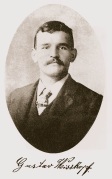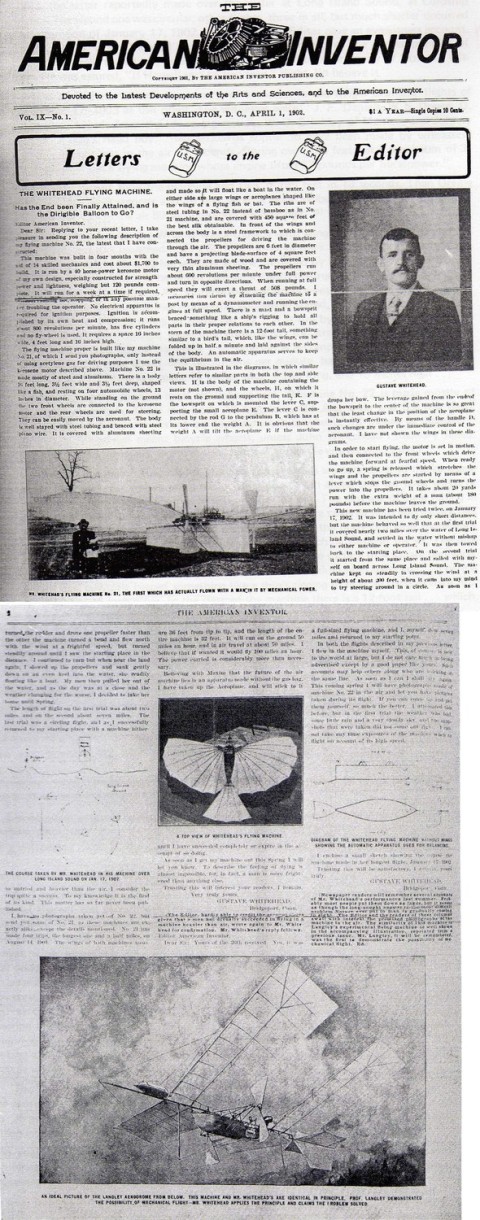1902-04, American Inventor, pp.1-2
Excerpt from
letter
dated January 17, 1902
"This
new
machine has been tried twice, on January 17, 1902. It was intended to fly only
short distances, but the machine behaved so well that at the first trial it
covered nearly two miles over the water of Long Island Sound, and settled in
the water without mishap to either machine or operator. It was then towed back
to the starting place. On the second trial it started from the same place and
sailed with myself on board across Long Island Sound. The machine kept on
steadily in crossing the wind at a height of about 200 feet, when it came into
my mind to try steering around in a circle. As soon as I turned the rudder and
drove one propeller faster than the other the machine turned a bend and flew
north with the wind at a frightful speed, but turned steadily around until I
saw the starting place in the distance. I continued to turn but when near the
land again, I slowed up the propellers and sank gently down on an even keel
into the water, she readily floating like a boat. My men then pulled her out of
the water, and as the day was at a close and the weather changing for the
worse, I decided to take her home until Spring.
The length
of
flight on the first was about two miles, and on the second about seven miles.
The last trial was a circling flight, and as I successfully returned to my
starting place with a machine hithero untried and heavier than air, I consider
the trip quite a success. To my knowledge it is the first of its kind. This
matter has so far never been published.
I have
no
photographs taken yet of No. 22 but send you some of No. 21 as these machines
are exactly alike, except the details mentioned. No. 21 has made four trips,
the longest one and a half miles, on August 14, 1901. The wings of both
machines measure 36 feet from tip to tip, and the length of the entire machine
is 32 feet. It will run on the ground 50 miles an hour, and in air travel at
about 70 miles. I believe that if wanted, it would fly 100 miles an hour. The
power carried is considerably more than necessary.
Believing with Maxim that the future of the air machine lies in an apparatus
made without the gas bag, I have taken up the aeroplane and will stick to it
until I have succeeded completely or expire in the attempt of so doing.
As soon as I get my machine out this Spring I will let you know. To describe
the feeling of flying is almost impossible, for, in fact, a man is more
frightened than anything else.
Trusting that
this
will interest your readers, I remain,
Very truly
yours,
Gustave Whitehead.
The editor
of
American Inventor wrote to Whitehead asking for confirmation, his reply
follows:
Editor,
American
Inventor
Dear Sir:
Yours of the
26th
received. Yes it was a full-sized flying machine and I, myself, flew seven
miles and returned to my starting point.
In both the
flights
described in my previous letter, I flew in the machine myself. This, of course,
is new to the world at large, but I do not care much in being advertised except
by a good paper like yours. Such accounts may help others along who are working
in the same line. As soon as I can I shall try again. This coming Spring I will
have photographs made of Machine No. 22 in the air and let you have pictures
taken during its flight. If you can come up and get them yourself, so much the
better. I attempted this before, but in the first trial the weather was bad,
some little rain and avery cloudy sky, and the snapshots that were taken did
not come out right. I cannot take any time exposures of the machine when in
flight on account of its high speed.
I enclose a
small
sketch showing the course the machine made in her longest flight, January 17,
1902.
Trusting this
will
be satisfactory, I remain,
Yours truly, Gustave Whitehead.
Editors Note in response:
Newspaper readers will remember several accounts of Mr. Whitehead's
performances last summer. Probably most people put them down as fakes, but it
seems as though the long-sought answer to the most difficult problem Nature
ever put to man is gradually coming in sight. The Editor and the readers of the
columns await with interest the promised photographs of the machine in the air.
The similarity of this machine to Langley.s experimental flying machine is well
shown in the accompanying illustration, reprinted from a previous issue. Mr.
Langley, it will be remembered, was the first to demonstrate the possibility of
mechanical flight.




